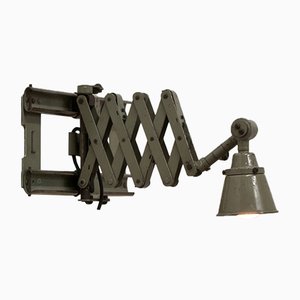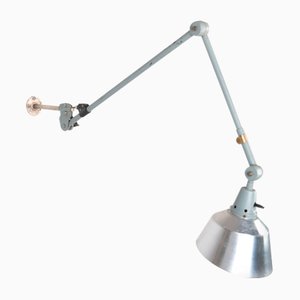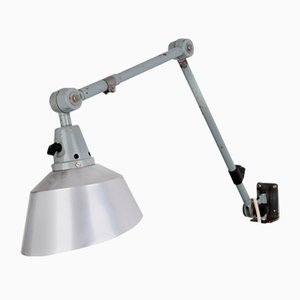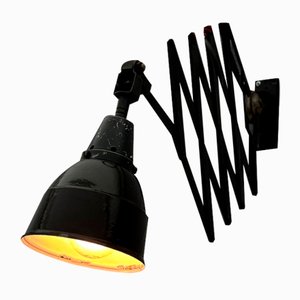German lighting manufacturer Midgard was founded in 1919 in Auma, Thuringia by industrial designer and engineer Curt Fischer (1890-1956). The company is known for producing the first articulated directional light designed by Fischer himself, which inspired a whole future generation of multifunctional task lights.
Fischer was an engineer for the machine factory Industriewerk Auma (IWA), which had originally produced machines for the production of industrial porcelain. In 1919, Fischer took over IWA, adding “Ronneberger and Fischer” to the factory’s name in memory of Konrad Ronneberger, who had founded the factory in 1912 and died in the First World War. Until the 1920s, the only available factory lighting was ceiling-mounted pendants, which provided static light and often casted unwanted shadows. Realizing there was a need for flexible lighting in industrial settings, Fischer created a light that could be articulated and steered in the direction of a factory worker’s desk or station. Originally designed for use at IWA, the Scissor Lamp (1919), which was patented on November 26, 1919, featured articulated tubes that allowed a cable to pass through and bend freely. In 1922, Fischer designed and added a glare-free reflector, which was rotatable and asymmetrical. The reflector ensured optimal directed light and protected the eyes of the factory worker using it.
In 1925, the first catalog was published with seven different styles of wall-mounted lamps available. By 1927, the catalog features of twenty different styles of lights. Notable lights produced by Midgard include the scissor-like 112 Trellis Wall Light (1922); the 113 Table Light (c. 1925), also known as the Whip Lamp because of the shape of the stem; the articulated 114 Hinge Lamp (1920s); the Machine Lamp (1930s) which features patented, maintenance-free joints; and the Spring-Loaded Lamp (1950s).
Walter Gropius admired Fischer and his designs, and was an active supporter of Fischer’s developments. The metal workshop at the Weimar Bauhaus was lit with Midgard lights and served as a model for the students’ designs. Gropius had Midgard lights his own living room at the Dessau Bauhaus.
Having continued production during and after the War, Fischer passed away in 1956, leaving the company to his son Wolfgang (b. 1924) who managed Midgard until the 1960s.
Located in East Germany, Midgard was expropriated in 1972 and the company was restructured and renamed VEB Industrieleuchtenbau Auma. VEB was the prefix given to all companies that were nationalized en masse in the socialist era. The company became the largest lighting manufacturer in East Germany, exporting to multinational retailers such as IKEA. Following the fall of the wall and the reunification of Germany in 1990, the company was re-privatized and returned to Wolfgang in the early 1990s, who reinstated the company’s original name. Although Midgard’s product line remained the same, Wolfgang worked on updating and improving the collection of desk lamps. From 2002 until 2008, Wolfgang’s step-daughters, Anja Specht and Susi Reifenstahl, joined the company, and reintroduced the classic Steering Lamp, including models 113 and 114. In 2011, all production ceased due to infrastructural problems.
In 2015, David Einsiedler and Joke Rasch - the founders of the Hamburg-based furniture company PLY - took over the company. In addition to all licensing rights to the Midgard task lamps, they also acquired the original tools, and Midgard’s exhaustive archive of original documents. The company relocated to Hamburg, where the production line was rebuilt, modernized, and put into operation in 2017. Today, Midgard continues to produce three classic Midgard lamps: the Steering Lamp, Machine Lamp, and Spring Loaded Lamp, with authentic vintage Midgard lamps also in demand by collectors.








